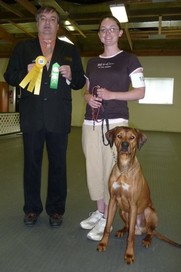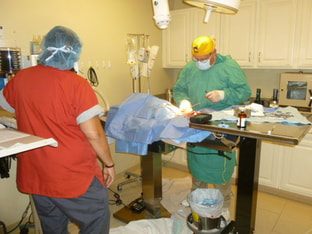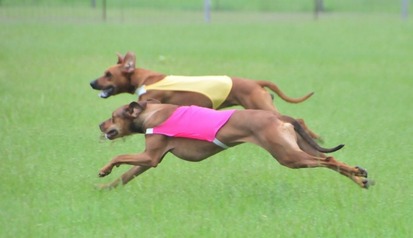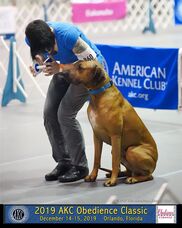- About Us
- Luvakis Rhodesian Ridgebacks
- Current Litter
- Planned Breedings
-
About Our Puppies
-
Information and Articles
- Breed History
- AKC Information
- AKC Breed Standard
- Important Links
- Dog Stuff We Can't Live Without!
- Recommended Readings
- Finding the Right Breeder
- One Puppy or Two?
- Dogs and Kids (Reading Canine Body Language)
- Tutorials: Ear Taping, Ear Wounds, Nail Dremeling >
- Collar Entrapment, Strangulation and CPCR Techniques Article
- What Does Bloat (GDV) Look Like?
- Contact Us
Luvakis Puppy and Puppy Owner Expectations
If you are interested in adopting a Luvakis Rhodesian Ridgeback puppy,
please read the following information thoroughly prior to contacting us.
Thank you.
Socialization and Training

Zulu earning his AKC CD Titie
As an obedience instructor and having a strong interest in behavior medicine, it is my goal to place every puppy with a family (whether for performance, show, breeding, or strictly companionship) that is willing to maintain not only its physical needs but also its mental needs. A well-behaved, well-socialized dog only comes from a puppy who is trained and worked with to reach his or her full potential as a companion animal. We start each of our puppies off on the right paw by utilizing the Puppy Culture Program. Once they leave for their new homes, we expect our puppy families to continue that positive momentum and strengthen the bond they form with their new puppy.
All puppies are required to complete a 6- to 8-week puppy kindergarten or basic socialization class with their new family. This puppy class must be started before puppy reaches 6 months of age. If locally available, we recommend participating in an AKC S.T.A.R. Puppy training class to earn puppy's AKC S.T.A.R. Puppy certificate.
All puppies will also be fitted with and have worked extensively in a Gentle Leader Headcollar. We provide all of our puppies with a fitted, medium headcollar and send an additional large headcollar home with our male puppies to grow into. Each puppy family is provided with personal instruction on how to properly fit their puppy with the headcollar (for when adjustment or moving up to the next size becomes necessary). An instructional DVD is also sent to answer any other questions that may arise down the road.
(We do not recommend Easy Walk Harnesses as puppies are growing because of the physical restriction of the upper arm when the harness is fitted properly. They can be a great training tool for an adult dog and should only be used once the dog has fully physically matured or over 18+ months of age.)
For our pet puppies not intended for the conformation ring, a minimum of one additional obedience/manners-based course is required to be completed before his/her 1st birthday, and a minimum of two additional courses (in any performance venue: obedience, Rally, tracking, agility, etc.) must be completed before his/her 2nd birthday. It is then up to the family to continue training at their leisure in order to strengthen the bond with their dog, continue socialization, prepare their dog for competition, or just as a fun outlet.
If destined for the show ring, puppies are expected to meet the same 1st-year core training requirements as their pet littermates, as well as concurrently participate in conformation classes or group practices/run-thrus. It is highly recommended they also complete the 2nd-year training requirements their pet littermates are required to complete.
All dogs, regardless of any other titles, are to attain their AKC Canine Good Citizen certification (or if in Canada, the Canadian Kennel Club Canine Good Neighbour certification) by their 2nd birthday.
It is also encouraged, though not required, for all puppies at least attempt to attain their AKC Junior Courser title (or Coursing Ability Test title, if puppy is ridgeless) or Fast CAT title anytime after 18 months of age. (No puppy is to ever be coursed at younger than 18 months of age.) We also highly encourage efforts towards AKC's Community and Urban Canine Good Citizen titles, as well as any Trick Dog, Agility Course Test (ACT), and/or Rally titles by puppy's 2nd birthday. These are easy and fun ways to expand training and bonding opportunities with your puppy!
Ridgebacks Really Do Obedience??
Disclaimer: Although Ridgebacks are not known to be top obedience, Rally or agility competitors, given the right incentives, motivation, and support, they will often give it their best effort. As you train your puppy, keep this very important phrase tucked in the front of your mind: Ridgebacks do not see the need or benefit in doing an exercise repetitively. They were bred to hunt (think) on their own, thus are not often willing to repeat exercises until the handler's idea of perfection is reached. Because of this trait, Ridgebacks are often deemed "difficult to train," but this can be avoided if you work with your dog's natural traits rather than struggle against them.
FYI for Your Puppy School Instructor: Many all-breed obedience instructors have not experienced training a sighthound. Do not be shy, explain to your instructor about your dog's natural desire to avoid repetitiveness when learning new skills or practicing old ones. A good instructor is open to insight about their students and is willing to tailor their instruction/class to help you and your dog succeed. Ask your instructor for stationary "doodling" exercises to add variety and keep your puppy's attention and focus on you during class; this will greatly help break up any repetitive exercises.
Training Tip: There can be a huge benefit to initially practicing some exercises without your dog. Subjecting your dog (or puppy) to practicing a skill over and over until you've gotten the hang of it quickly equates to unnecessary repetition to most Ridgebacks. When starting a new exercise, practice your commands, speed, leash carriage, treat timing, as well as foot and hand work before adding your dog into the mix. In the end, this will make it easier for you to coordinate your efforts with your dog and for you work as a team. When you already know your part, you can then concentrate on teaching your dog their part.
FYI for Your Puppy School Instructor: Many all-breed obedience instructors have not experienced training a sighthound. Do not be shy, explain to your instructor about your dog's natural desire to avoid repetitiveness when learning new skills or practicing old ones. A good instructor is open to insight about their students and is willing to tailor their instruction/class to help you and your dog succeed. Ask your instructor for stationary "doodling" exercises to add variety and keep your puppy's attention and focus on you during class; this will greatly help break up any repetitive exercises.
Training Tip: There can be a huge benefit to initially practicing some exercises without your dog. Subjecting your dog (or puppy) to practicing a skill over and over until you've gotten the hang of it quickly equates to unnecessary repetition to most Ridgebacks. When starting a new exercise, practice your commands, speed, leash carriage, treat timing, as well as foot and hand work before adding your dog into the mix. In the end, this will make it easier for you to coordinate your efforts with your dog and for you work as a team. When you already know your part, you can then concentrate on teaching your dog their part.
When it comes to Ridgebacks and obedience, remember:
► keep up the motivation (especially food and praise) ◄
► keep training sessions short and sweet ◄
► end on a positive note ◄
and above all else,
►►HAVE FUN!◄◄
(It may not always seem like it, but it does get easier.)
Health Screenings

We want to assure all our new puppy families that our goal is to strive to produce only the most sound, healthy offspring that represent the best of our breed. Because of this, we require more of our puppies (both pet and breeder/show prospect placements) than many breeders. Please know there are NO exceptions to these requirements and puppies will only be placed in homes that are willing to meet (or exceed) these requirements.
Puppies placed as pets: If we only require those puppies destined to become part of a breeding program to be tested for tendencies towards certain health concerns, we would only get a small part of the genetic picture. Because of this, we require ALL of our puppies placed as pets to have the same evaluations as those placed as breeding/show prospects. These are some differences in age and/or frequency of testing between pet and breeder dogs; please see below for further details.
Puppies placed as breeder/show prospects: We expect puppies that are to become part of a breeding program or will be exhibiting in the conformation ring to obtain and maintain their CHIC + patella, + cardiac (echo), + BARE, + DM, as well as PennHip evaluation. Any additional testing above and beyond this is encouraged and greatly appreciated.
|
OFA Eye Certification
Click here for information about OFA Eye Certification testing The form for your dog's eye test is only available from the ophthalmologist at the time of the exam. Please be sure to take your dog's AKC registration number and microchip number to this appointment. - Pet: at least 1 time between 1 and 3 years of age. - Breeder: annually from 12 months until 6 years of age or they are no longer part of a breeding program, then every other year thereafter |
OFA Thyroid Testing
Click here for information about Autoimmune Thyroiditis Click here for the OFA Application for Thyroid Database form Please note: The blood sample for this test must be sent to an OFA-approved lab, this is NOT an in-house thyroid screening your veterinarian can perform for you. - Pet: at least 1 time at 12-24 months of age (often drawn in conjunction with pre-op bloodwork for spay/neuter procedure) - Breeder: initially at 12-24 months of age, then repeated at 3, 4, 6 and 8 years of age (per OFA recommendations) |
|
OFA Patellar Luxation Exam
Click here for information about Patellar Luxation Click here for the OFA Application for Patellar Luxation Database form - Pet: once at 12 months of age during pre-anesthetic exam during spay/neuter procedure - Breeder: once at 24 months of age or as part of pre-breeding health evaluation |
OFA Elbow Exam
Click here for information about Elbow Dysplasia Click here for the OFA Application for Hip/Elbow Dysplasia Database form - Pet: once at 12 months of age while anesthetized for spay/neuter procedure - Breeder: once at 24 months of age or as part of pre-breeding health evaluation |
|
OFA Hip Exam
Click here for information about Hip Dysplasia Click here for the OFA Application for Hip/Elbow Dysplasia Database form - Pet: once at 12 months of age while anesthetized for spay/neuter procedure - Breeder: once at 24 months of age or as part of pre-breeding health evaluation |
PennHIP Exam
Click here for information about PennHip evaluation Click here to locate a PennHip certified veterinarian - Pet: recommended, but not required - Breeder: once at 24 months of age or as part of pre-breeding health evaluation |
|
OFA Cardiac Exam
Click here for information about Congenital Cardiac Disease Click here for the OFA Application for Congenital Cardiac Database form - Pet: at least 1 time at 12-24 months of age; auscultation accepted, echo preferred - Breeder: at least 1 time at 12-24 months of age; echocardiogram with (colour-flow) Doppler + ECG required (OFA ACA forms are only available from the veterinary cardiologist performing the echocardiogram) Degenerative Myelopathy (DM) DNA Testing
Click here for information about Degenerative Myleopathy Click here to order a Degenerative Myelopathy (DM) DNA test kit from OFA Click here to order an Embark DNA test kit, which includes testing for 230+ health conditions, including DM genetic testing - Pet: once at any age (recommended to be preformed at the same time as other health screenings) - Breeder: once at any age, but prior to breeding |
BAER or EOAD (hearing) Testing
Click here for information about BAER testing Click here for the OFA Application for Congenital Deafness Database form (BAER testing) Click here for information about Early-Onset Adult Deafness in the Ridgeback Click here to order an Embark DNA test kit, which includes testing for 230+ health conditions, including EOAD genetic testing - BAER Pet: recommended, but not required; if performed, initially at 12 months of age, then repeated again at 5-7 years of age - BAER Breeder: recommended, but not required; if performed, initially at 12 months of age, then repeated again at 5-7 years of age; because no standard protocol for screening for adult onset deafness has yet been set forth by OFA, it is strongly recommended potential breeding animals be tested at 12 months of age, then again at 3, 5, 7 and 10 years of age - EOAD Pet: once at any age (recommended to be preformed at the same time as other DNA health screenings) - EOAD Breeder: once at any age, but prior to breeding |
Spaying and Neutering

We realize this has become a controversial topic in recent years, however, all of our puppies placed in pet homes are required to be spayed or neutered. That said, we do not wish for our dogs or bitches to be surgically (or chemically) sterilized until they are at least 12 months of age. Part of the reasoning for this reflects the fact that some of puppy's required health screening tests have an age restriction and are only able to be performed once puppy reaches 12 months (exactly) of age. By requiring puppies to wait until at least 12 months of age before spaying or neutering, allows for those health screening tests requiring chemical restraint (such as OFA hip/elbow radiographs) to be performed in tandem with puppy's surgery, utilizing the same anesthesia event and helping reduce anesthesia risk and cost.
Male Puppies
Males are required to be surgically (or chemically) sterilized between 12 and 18 months of age. Those puppies placed in responsible homes demonstrating the ability to adequately train and appropriately control their dog may wait up to an additional 6 months prior to castration, if the owner feels the dog's current exercise or training regimen demands a delay in sterilization and ONLY with our permission.
Female Puppies
It is most ideal for bitches to be spayed as soon after their 1 year birthday as possible to avoid their first estrus cycle. We encourage our puppy families to avoid their puppy's first estrus cycle, but this is not always possible. Additionally, some of our more experienced owners or owners of bitches expected to regularly participate in heavy-impact or strenuous exercise (ex. endurance or distance running, agility training, etc.) may wish to allow their bitch to go through her first estrus cycle. Because of these scenarios, our female puppies are required to be surgically sterilized between 12 months of age and 4-6 weeks after all signs of their first estrus cycle have subsided. Should you choose to allow your bitch to complete her first estrus cycle, the utmost care must be taken to avoid an accidental breeding (leash-walked in a fenced yard to potty, no walks outside their own yard, no dog park visits, no visits to the pet store, no intact male canine visitors/playdates of any age, 24/7 separation from intact male canine housemates of any age, etc.)! Remember, a maiden bitch's first cycle can last 3-5 weeks!
"But my vet (or trainer or doggy daycare provider) requires me to spay/neuter at 6 months of age."
Any vet that requires this of you is likely not open to newer information and prefers to stick to what they were taught as "tried and true" when they first started practicing many years ago. This may sound harsh, but any veterinarian who pressures a client into making a decision their client is otherwise in objection to is not advocating for their client or their patient. Find Another Vet.
Any trainer that will not allow a juvenile or adult dog to attend classes unless sterilized is also likely lacking current information. In fact, there are now many advocates (trainers, researchers and animal health care professionals) who feel dogs, especially large breed dogs, who regularly participate in heavy-impact or strenuous exercise (ex. endurance or distance running, agility, etc.) should not be sterilized until retired. Again, if your trainer or training facility is not open to your puppy being spayed or neutered until a year or 18 months of age, Find Another Trainer.
Doggy daycare is a bit different. There are numerous advantages to your puppy, juvenile or even adult dog attending doggy daycare. The social aspect from a well-run and well-managed doggy daycare facility can be a huge asset to your canine companion. Especially for those who have demanding jobs or who work especially long hours, a doggy daycare facility can often make the task of rearing your puppy or occupying your juvenile or adult dog for long stretches throughout the day a whole lot easier. At this juncture, please discuss this matter with us to help you make the right decision for your situation and your puppy. Do keep in mind not all doggy daycare facilities require sterilization of their participants, some merely require you to keep your female at home or may allow her to attend but require her to be separated from the playgroup while she is in estrus. Along these same lines, some facilities may choose to discontinue services to your male puppy if he becomes too disruptive to the balance of the playgroup when he starts to become sexually mature.
To save you unwanted stress and anxiety, it is advantageous to inquire about a particular veterinary or training facility's spay/neuter requirements when interviewing them before your new puppy arrives.



